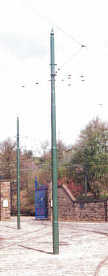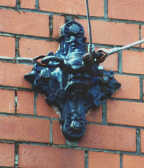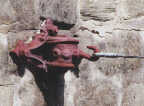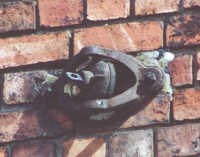Did You Know...?
Supplying the Power
The overhead power lines which carried the electricity to the trams were
supported in various ways. The methods varied according to the width of the
roads and pavements, the cost of development of the route and possibly the
strength of local feelings. In Coventry, the following methods were used:
 Brackets on poles had the appearance of modern day street lighting
columns. They were often quite ornamental. The bracket stretched out over the
tram track at right angles to the pole and the power line was suspended above
the track. Brackets were generally positioned just on one side of the road,
or sometimes in between double tracks, particularly in Broadgate. This
section of a commercial postcard shows poles with ornamental brackets in use
in Broadgate about 1900.
Brackets on poles had the appearance of modern day street lighting
columns. They were often quite ornamental. The bracket stretched out over the
tram track at right angles to the pole and the power line was suspended above
the track. Brackets were generally positioned just on one side of the road,
or sometimes in between double tracks, particularly in Broadgate. This
section of a commercial postcard shows poles with ornamental brackets in use
in Broadgate about 1900.
 Span wires on poles were quite similar. However, there would usually a
pole on either side of the road. A taut wire - the span wire - was stretched
between them, from which the power line was suspended. This view of a pole
at the National Tramway Museum, Crich illustrates the principle.
Span wires on poles were quite similar. However, there would usually a
pole on either side of the road. A taut wire - the span wire - was stretched
between them, from which the power line was suspended. This view of a pole
at the National Tramway Museum, Crich illustrates the principle.

 Rosettes were often used where there was insufficient space on the pavement
for poles. These were quite simply cast iron fixtures which to buildings from
which span wires could be hung. These two pictures show rosettes in use
at the National Tramway Museum, Crich.
Rosettes were often used where there was insufficient space on the pavement
for poles. These were quite simply cast iron fixtures which to buildings from
which span wires could be hung. These two pictures show rosettes in use
at the National Tramway Museum, Crich.
 Photographs of streetscenes in
Coventry show that the rosettes used in the City were less ornate. One such
rosette - illustrated here - still exists on a wall in Hales Street. There
were many more in the centre of Coventry, but the wartime blitz and postwar
redevelopment removed many of the buildings to which they were attached.
However, it is still possible to see where some of the rosettes were fixed. On
the Argos building in the Burges, on the side of the NatWest Bank in Broadgate
- Hertford Precinct side - and at various points on the pre-war buildings on the
eastern side of Hertford Street, the fixing holes can still be seen.
Photographs of streetscenes in
Coventry show that the rosettes used in the City were less ornate. One such
rosette - illustrated here - still exists on a wall in Hales Street. There
were many more in the centre of Coventry, but the wartime blitz and postwar
redevelopment removed many of the buildings to which they were attached.
However, it is still possible to see where some of the rosettes were fixed. On
the Argos building in the Burges, on the side of the NatWest Bank in Broadgate
- Hertford Precinct side - and at various points on the pre-war buildings on the
eastern side of Hertford Street, the fixing holes can still be seen.
As originally opened, routes were equipped as follows:
|
Railway Station - Bedworth |
Generally span wires on poles, but with rosettes on buildings and brackets on
poles in the city. |
|
Burges junction - Bell Green |
Rosettes and span wires to Ford Street. There were brackets on poles
beyond, with occasional span wires on rosettes. |
|
Ford Street - Stoke |
Brackets on poles with occasional span wires on rosettes. |
|
Jesson Street - Gosford Green |
Brackets on poles were used throughout. |
|
Broadgate - Allesley Road and Earlsdon |
Span wires on rosettes to Fleet Street and span wires on poles beyond. |
In 1911, there were 264 brackets on poles, 560 span poles and 109 rosettes.
61 rosettes were used on the Bedworth route, 11 to Bell Green, 8 between Ford
Street and Stoke, 3 between Jesson Street and Gosford Green and 26 between
Broadgate and Fleet Street on the Allesley Road route.
 Feeder pillars were positioned at various points on the network to enable the
system to be connected to the electricity supply. Records still in existence
show that those at Swanswell, Hales Street and Eagle Street dating from 1899
were 6' 0" tall and 22" x 22". They were possibly round as used on other
systems, rather like post boxes. Others at New Inn, Broadgate and Spon End -
the latter two dating from 1905 - were 4' 10" tall and 18" x 14". No example
of a Coventry feeder pillar remains. This blue British Electric Traction
feeder pillar is preserved at Poole.
Feeder pillars were positioned at various points on the network to enable the
system to be connected to the electricity supply. Records still in existence
show that those at Swanswell, Hales Street and Eagle Street dating from 1899
were 6' 0" tall and 22" x 22". They were possibly round as used on other
systems, rather like post boxes. Others at New Inn, Broadgate and Spon End -
the latter two dating from 1905 - were 4' 10" tall and 18" x 14". No example
of a Coventry feeder pillar remains. This blue British Electric Traction
feeder pillar is preserved at Poole.
Keeping the Track Maintained
For the tram system to operate as smoothly as possible, regular maintainance
was necessary to keep the trackwork in good condition. Track renewal took
place on an ongoing basis. The following are examples of work undertaken and
the cost.
- 1906 - Replacement of 14 crossings dating from 1899. Cost £261 9s 0d (£261.45).
- 1907 - Replacement of 9 crossings of 1899, points, crossings and rails at the
Hales Street/Ford Street junction and work at Prince William Henry Bridge.
Cost £580 12s 8d (£580.63).
- 1908 - Replacement of 9 crossings from 1899, curved rail opposite 'The Golden
Fleece' at Bell Green and curved rail at the Burges/Hales Street junction.
Cost £391 7s 9d (£391.39).
- 1909 - Replacement of points and crossings at Priestley's Bridge Depot, 3
crossings dating from 1899, track at the Vernon Street end of the Paynes
Lane/Vernon Street curve, all points, crossings and rails at the Hales
Street/Jesson Street junction and straight rails between Ford Street and
Jesson Street. Cost £611 12s 10d (£611.64).
- 1910 - Three crossings and the double track junction into Smithford Street,
track at the Paynes Lane end of the Paynes Lane/Vernon Street curve, points
at the Cambridge Street turnout, points and crossings at the Burges/Hales
Street junction, a crossing in the Burges and points in Hales Street. Cost
£696 3s 8d (£696.18).
Remember these prices are nearly 100 years old. Wages and prices were very
much lower then! In 1906, £1 0s 0d was worth approximately £66 in present day
terms. However, It would be wrong to assume that the £391 7s 9d spent on the
work shown would be nearly £26,000 today. Other factors such as the cost of
individual materials, wages and mechanisation are likely to have increased at
different rates. For example, a pint of beer cost the equivalent of just
under 1p in 1906, but rather than 66p, the cost today is generally over
£1.00.
Operating Costs
A summary of operating costs and revenue for the years 1898 - 1910 is held in
the City Council archives. These were compiled during the lead up to the sale
of the system to the Corporation. The figures reproduced below cover the years
1898, 1900 and 1910. The method of recording information varied over the years.
Some data was not recorded and this is shown * in the table for 1898. Similarly,
prior to 1900, all operating expenses were included under the "Electrical
Engineering" heading. Later the costs for renewals of tramcars and track was
separated out, but, prior to 1907 included cleaning costs.
| |
1898 |
1900 |
1910 |
| Miles of Route |
5.75 |
10.56 |
12.88 |
| Miles of Single Track |
7.00 |
12.70 |
15.57 |
| Passengers - Ordinary |
1,389,920 |
2,715,229 |
5,066,278 |
| Passenger - Workmen |
* |
332,080 |
881,286 |
| Total Passengers |
1,389,920 |
3,037,309 |
5,947,564 |
| Car Miles |
278,385 |
542,891 |
885,929 |
| Coal per Car Mile (lbs) |
22.94 |
12.18 |
9.70 |
| Total Coal used (tons) |
2,851 |
2,952 |
3,836 |
| Gross Receipts |
£10,510 |
£17,015 |
£31,078 |
| Receipts per Car Mile |
£0.0378 |
£0.0313 |
£0.0351 |
| Receipts per Passenger |
|
|
|
| Ordinary |
£0.0076 |
£0.0050 |
£0.0045 |
| Workmen |
* |
£0.0006 |
£0.0008 |
| Total |
£0.0076 |
£0.0056 |
£0.0052 |
| Repairs and Renewals |
|
|
|
| Tramcars |
* |
£2,047 |
£3,145 |
| Track |
* |
£1,037 |
£2,096 |
| Electrical Engineering |
* |
£174 |
£476 |
| Total |
* |
£3,258 |
£5,717 |
| Total per Car Mile |
* |
£0.0060 |
£0.0065 |
It is interesting to note that whilst the miles of route had increased by 124%
between 1898 and 1910, the total passengers carried had increased by over 300% and it was
taking nearly 60% less coal per car mile to produce the electricity to power the trams.
Over this period, Coventry's trams covered nearly 8 million miles carrying nearly 50 million
passengers in the process. However, gross receipts had increased by less than 200%
between 1898 and 1910 which meant that receipt per passenger was less - 30.9% less in fact.
Costs were clearly on the increase for repairs and renewals. No figures are
available for 1898, but as the system was then just a few years old, the outlay in
this area was hopefully minimal. Between 1900 and 1910 when figures are known, the
overall cost of repairs and renewals had increased by 75%. That on the tramcars
themselves was the highest actual figure, but at less that 55% it was growing the
least. Conversely, the smallest figure of £476 in 1910 for electrical engineering
represented a 173% increase over 10 years. These are just 'snapshot' figures for
the years concerned. The total gross revenue between 1900 and 1910 was £269,604
whilst the total costs for repair and renewals was £28,067 for tramcars, £14,554
for track and £3,999 for electrical engineering.
Bus Services
As early as March 1913, the Council was considering a network of bus routes
in Coventry. Proposed were routes from Broadgate to
- Allesley via Smithford Street and Allesley Old Road,
- Allesley via Smithford Street and Holyhead Road,
- Bedworth,
- Bell Green,
- Binley via High Street and Binley Road,
- Clay Lane,
- Gibbet Hill via Hertford Street and Kenilworth Road,
- Heath Road,
- Keresley via Bishop Street and Radford Road,
- Walsgrave on Sowe via High Street and Walsgrave Road,
- Willenhall via High Street, Much Park Street and London Road.
Interestingly two of the proposed routes, to Bedworth and Bell Green, were
already served by trams, whilst many of the rest can be recognised in the
present day bus network.
|
|